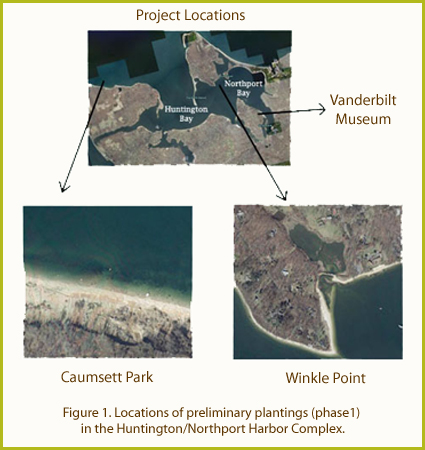
Methods:
Phase I: Small-Scale
Eelgrass Pilot Plantings
Initial
plantings, during the first year, will be of small scale (< 1 acre total)
to determine the most suitable sites for the larger scale plantings during phase
II and III. Adult eelgrass shoots will be collected from several Long Island
Sound (LIS), Peconic Estuary and/or South Shore Estuary Reserve eelgrass meadows.
Collecting will involve non-destructive gathering of uprooted shoots resulting
from natural disturbances (e.g., storm events). These shoots will be maintained
at Cornell Cooperative Extension's greenhouse in Southold until sufficient numbers
are gathered for planting. The results of Phase I plantings will provide the
data necessary to select sites most suited for large-scale planting (Phase II).
Phase II: Large-Scale Eelgrass Plantings
The results of the preliminary plantings (Phase I) will provide
the basis for site selection and large-scale plantings (Phase II). We expect
to select a subset of 2 to 3 sites for more intense plantings utilizing both
transplants and seeds. Broadcast seeding will follow the methods used in the
Peconic Estuary involving gathering mature reproductive shoots from extant meadows
during July-August. Collections will include seeds from the Peconic Estuary,
Long Island Sound and/or South Shore Estuary Reserve. After collection, reproductive
shoots will be transported to the greenhouse and placed in holding tanks to
allow for natural seed release. Ripe seeds will be broadcast at planting sites
at a rate of 100-250 m2 in September or October. Eelgrass planting plots will
be monitored at least monthly to determine percent survival and germination.
Monitoring involves the use of SCUBA gear, underwater digital video equipment
and quadrant methods. Initially, survival percentages will be compared to the
number of shoots deployed. Once established, survival and spread are measured
relative to unit area using scaled quadrants.
Phase III: Bay Scallop Plantings
In year three, we will continue to monitor the Phase II plantings
for survival and shoot density. The most successful eelgrass planting sites
will then be the focus of bay scallop enhancement. At selected sites a total
of approximately 200,000 bay scallops (average size, 35 mm) will be planted.
Planting will take place (April) with scallops that have over wintered and are
ready to spawn. Care will be taken to ensure that all scallops are dispersed
directly into established vegetation to minimize the risk of predation. Eelgrass
planting plots will be monitored at least monthly to determine percent survival
and germination. Monitoring involves the use of SCUBA gear, underwater digital
video equipment and quadrant methods. Initially, survival percentages will be
compared to the number of shoots deployed. Once established, survival and spread
are measured relative to unit area using scaled quadrants. We will also use
SCUBA survey methods with quadrants to determine scallop densities within eelgrass
beds and use SPAT collectors to quantify spawning and recruitment success. Spawning
success will be assessed by deploying spat collectors adjacent to the planting
sites during June/July. Success will be determined based on the number of bug
scallops observed on the eelgrass blades and each spat collector.
|

